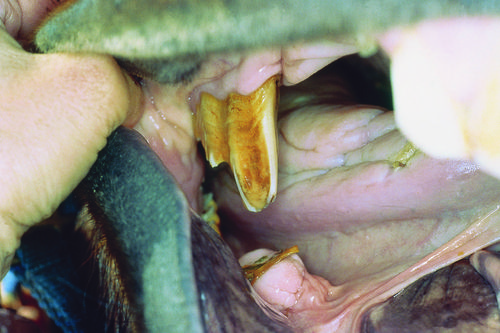Difference between revisions of "Veterinary Dentistry Q&A 19"
Ggaitskell (talk | contribs) |
|||
| (One intermediate revision by the same user not shown) | |||
| Line 1: | Line 1: | ||
| + | {{Template:Manson | ||
| + | |book = Veterinary Dentistry Q&A}} | ||
| + | |||
[[File:Vet Dentistry 19.jpg|centre|500px]] | [[File:Vet Dentistry 19.jpg|centre|500px]] | ||
| Line 15: | Line 18: | ||
This horse was only nine years old but had four places where tall/long parts of teeth were traumatizing the gingiva and rubbing on bone. | This horse was only nine years old but had four places where tall/long parts of teeth were traumatizing the gingiva and rubbing on bone. | ||
| − | |l1= | + | |l1=Abnormal Wear of Teeth |
|q2=Name the commonly used techniques for correcting this problem. | |q2=Name the commonly used techniques for correcting this problem. | ||
|a2= | |a2= | ||
There are many techniques for removing tall/long hooks. Molar cutters, Dremel™-type instruments with burrs, chisels, and floats may be used to reduce the tall areas. | There are many techniques for removing tall/long hooks. Molar cutters, Dremel™-type instruments with burrs, chisels, and floats may be used to reduce the tall areas. | ||
| − | |l2= | + | |l2=Abnormal Wear of Teeth#Treatment |
</FlashCard> | </FlashCard> | ||
Latest revision as of 20:28, 15 October 2011
| This question was provided by Manson Publishing as part of the OVAL Project. See more Veterinary Dentistry Q&A. |
This nine-year-old Quarter horse mare was presented with progressive weight loss.
| Question | Answer | Article | |
| What dental problem is visible? | A long right maxillary second premolar hook is present that has penetrated the gingiva and is rubbing on the mandible. The left maxillary second premolar has a similar hook. The mandibular third molars should always be examined for the presence of hooks or ramps, especially when the mesial portion of the maxillary second premolars are not in occlusion, as the distal portion of the mandibular third molars may not be in occlusion, also resulting in hook or ramp formation. This horse was only nine years old but had four places where tall/long parts of teeth were traumatizing the gingiva and rubbing on bone. |
Link to Article | |
| Name the commonly used techniques for correcting this problem. | There are many techniques for removing tall/long hooks. Molar cutters, Dremel™-type instruments with burrs, chisels, and floats may be used to reduce the tall areas. |
Link to Article | |
